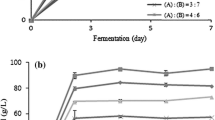Summary
An excess of organic waste, containing up to 60% cellulose and hemicellulose is produced worldwide. The conversion of this cellulosic material to ethanol is discussed: The two-step process consisting of a hydrolysis step to glucose and the subsequent fermentation by yeasts; and the one-step process, a fermentation of the cellulose by the anaerobic thermophileClostridium thermocellum, or by a thermophilic, anaerobic, defined mixed culture. The use of the latter seems to be very feasible., To achieve an economic process, it is suggested to combine this approach with a thermophilic fermentation of the effluent and/or stillage obtained to produce methane.
Similar content being viewed by others
References
B. Finnerty, in: Microbial Energy Conversion, p. 83. Ed. H. G. Schlegel and J. Barnea. Erich Golze KG, Göttingen 1976.
B. Berg, Archs Microbiol.118, 61 (1978).
L. A. Spano, in: Microbial Energy Conversion p. 157. Ed. H. G. Schlegel and J. Barnea. Erich Goltze KG, Göttingen 1976.
H. Sahm, in: Rothenburger Symposium, p. 75. Braun AG, Melsungen 1978.
The National Biomass Program, 3rd Annual Biomass Energy System Conference Proceedings, SERI/TP 33-285 (1979).
G. Halliwell, Prog. ind. Microbiol.15 1 (1979).
T. K. Ghose, in: Bioconversion of Cellulosic Substances into Energy, Chemicals and Microbial Protein, p. 599. New Delhi 1977.
R. E. Hungate, The Rumen and its Microbes. Academic Press, New York 1967.
M. Linko, in: Microbiology applied to Biotechnology; Dechema Monographie No. 83, p. 209, Verlag Chemie, Weinheim/New York 1979.
A. E. Humphrey, A. Moreira, W. Armiger and D. Zabriskie, Biotech. Bioengng Symp.7, 45 (1977).
D. S. Chaha, J. E. Swan and M. Moo-Young Devs ind. Microbiol.18, 433 (1977).
T. C. Rexen, Animal Fd Sci. Technol.1, 73 (1976).
Y. W. Han and C. D. Callihan, Appl. Microbiol.27, 159 (1974).
G. H. Grant, Y. W. Han and A. W. Anderson, Appl. environ. Microbiol.35, 549 (1978).
M. R. Ladisch, C. M. Ladisch and G. T. Tsao, Science201, 743 (1978).
E. T. Reese and M. Mandels, Biotechnol. Bioengng22, 323 (1980).
R. F. Gomez, in: Proc. Colloque Cellulolyse Microbienne, p. 177, Marseille 1980.
I. C. Wang, I. Biocic, H.-Y. Fang and S.-D. Wang, in: Proc. 3rd Annual Biomass Energy System Conference, SERI/TP 33-285 (1979).
J. Wiegel, Experientia,36, 1434 (1980).
J. E. L. Corry, J. Bact.44, 1 (1978).
J. G. Zeikus, Env. Microbiol. Tech.1, 243 (1979).
M. Tansey, ASM-News45, 417 (1979).
S. L. Rosenberg, Mycologia70, 1 (1978).
W. D. Belamy, ASM-News45, 326 (1979).
J. Wiegel, in preparation.
C. L. Cooney, D. I. C. Wang, S. D. Wang, I. Gordon and M. Jiminez, Biotechnol. Bioengng Symp.8, 103 (1979).
D. V. Garcia-Martinez, A. Shinmyo, A. Madia and A. L. Demain, Eur. J. appl. Microbiol.9, 189 (1980).
N. D. Sjolander, J. Bact.34, 419 (1937).
E. J. Hsu and Z. J. Ordal, J. Bact.102, 369 (1970).
J. Wiegel and L. G. Ljungdahl, in: Technische Mikrobiologie, p. 117. Ed. H. Dellweg. Verlag Versuchs- und Lehranstalt für Spiritusfabrikation und Fermentationstechnologie im Institut für Gärungsgewebe und Biotechnologie, Berlin 1979.
J. Wiegel, L. G. Ljungdahl and J. R. Rawson, J. Bact.139, 800 (1979).
J. Wiegel and L. G. Ljungdahl, Archs Microbiol.,128, 343 (1981).
L. G. Ljungdahl and J. Wiegel, USA patents 4.292.406 and 4.292.407 (1981).
H. Dellweg and K. Misselhorn, in: Microbiology applied to Biotechnology; Dechema Monographie No. 83, p. 35. Verlag Chemie, Weinheim/New York 1979.
H. H. Dietrichs, Holzforschung32, 193 (1978).
S. I. Aronovsky and R. A. Gortner, Indian Engng Chem.28, 1270 (1936).
Author information
Authors and Affiliations
Additional information
Acknowledgment. Part of this work was supported by Energy and Research Development Administration contract number EY-76-509-0888-M003, and by the Deutsche Forschungsgemeinschaft.
Rights and permissions
About this article
Cite this article
Wiegel, J. Ethanol from cellulose. Experientia 38, 151–156 (1982). https://doi.org/10.1007/BF01945067
Published:
Issue Date:
DOI: https://doi.org/10.1007/BF01945067




